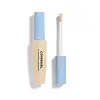What's inside
What's inside
 Key Ingredients
Key Ingredients

 Benefits
Benefits

 Concerns
Concerns

 Ingredients Side-by-side
Ingredients Side-by-side

Water
Skin ConditioningCyclopentasiloxane
EmollientButylene Glycol
HumectantCetyl PEG/PPG-10/1 Dimethicone
EmulsifyingEthylhexyl Methoxycinnamate
UV AbsorberTrimethylsiloxysilicate
EmollientSilica Silylate
EmollientSodium PCA
HumectantTalc
AbrasiveAcrylates/C12-22 Alkyl Methacrylate Copolymer
C12-15 Alkyl Ethylhexanoate
EmollientDimethicone/Vinyl Dimethicone Crosspolymer
Skin ConditioningMagnesium Sulfate
Zinc Stearate
Cosmetic ColorantBis-PEG/PPG-14/14 Dimethicone
EmollientAmodimethicone
Laureth-7
EmulsifyingLecithin
EmollientTribehenin
EmollientMethylparaben
PreservativeDisteardimonium Hectorite
StabilisingPhenoxyethanol
PreservativeTrihydroxystearin
Skin ConditioningTriethoxycaprylylsilane
Dimethiconol
EmollientXanthan Gum
EmulsifyingPropylparaben
PreservativePentylene Glycol
Skin ConditioningTocopheryl Acetate
AntioxidantPropylene Carbonate
SolventHydroxyethylcellulose
Emulsion StabilisingBHT
AntioxidantPentaerythrityl Tetra-Di-T-Butyl Hydroxyhydrocinnamate
AntioxidantCI 77891
Cosmetic ColorantIron Oxides
Water, Cyclopentasiloxane, Butylene Glycol, Cetyl PEG/PPG-10/1 Dimethicone, Ethylhexyl Methoxycinnamate, Trimethylsiloxysilicate, Silica Silylate, Sodium PCA, Talc, Acrylates/C12-22 Alkyl Methacrylate Copolymer, C12-15 Alkyl Ethylhexanoate, Dimethicone/Vinyl Dimethicone Crosspolymer, Magnesium Sulfate, Zinc Stearate, Bis-PEG/PPG-14/14 Dimethicone, Amodimethicone, Laureth-7, Lecithin, Tribehenin, Methylparaben, Disteardimonium Hectorite, Phenoxyethanol, Trihydroxystearin, Triethoxycaprylylsilane, Dimethiconol, Xanthan Gum, Propylparaben, Pentylene Glycol, Tocopheryl Acetate, Propylene Carbonate, Hydroxyethylcellulose, BHT, Pentaerythrityl Tetra-Di-T-Butyl Hydroxyhydrocinnamate, CI 77891, Iron Oxides
Water
Skin ConditioningCyclopentasiloxane
EmollientPropylene Glycol
HumectantDimethicone
EmollientTalc
AbrasivePPG-13
Skin ConditioningAluminum Starch Octenylsuccinate
AbsorbentSodium Chloride
MaskingPvp
Emulsion StabilisingLaureth-7
EmulsifyingSodium Dehydroacetate
PreservativeSynthetic Beeswax
Emulsion StabilisingTrihydroxystearin
Skin ConditioningMethylparaben
PreservativePropylparaben
PreservativeSilica
AbrasiveEthylene/Methacrylate Copolymer
Synthetic Wax
AbrasivePolyglyceryl-4 Isostearate
EmulsifyingCetyl PEG/PPG-10/1 Dimethicone
EmulsifyingHexyl Laurate
EmollientEthylene Brassylate
MaskingPolyethylene
AbrasiveAluminum Hydroxide
EmollientStearic Acid
CleansingIsopropyl Titanium Triisostearate
EmollientCI 77891
Cosmetic ColorantIron Oxides
Water, Cyclopentasiloxane, Propylene Glycol, Dimethicone, Talc, PPG-13, Aluminum Starch Octenylsuccinate, Sodium Chloride, Pvp, Laureth-7, Sodium Dehydroacetate, Synthetic Beeswax, Trihydroxystearin, Methylparaben, Propylparaben, Silica, Ethylene/Methacrylate Copolymer, Synthetic Wax, Polyglyceryl-4 Isostearate, Cetyl PEG/PPG-10/1 Dimethicone, Hexyl Laurate, Ethylene Brassylate, Polyethylene, Aluminum Hydroxide, Stearic Acid, Isopropyl Titanium Triisostearate, CI 77891, Iron Oxides
Ingredients Explained
These ingredients are found in both products.
Ingredients higher up in an ingredient list are typically present in a larger amount.
This ingredient is a high molecular weight silicone. It has emulsifying and skin conditioning properties.
Ci 77891 is a white pigment from Titanium dioxide. It is naturally found in minerals such as rutile and ilmenite.
It's main function is to add a white color to cosmetics. It can also be mixed with other colors to create different shades.
Ci 77891 is commonly found in sunscreens due to its ability to block UV rays.
Learn more about CI 77891Cyclopentasiloxane, or D5, is a silicone used to improve texture of products and trap moisture.
D5 is considered lightweight and volatile. Volatile means it evaporates quickly after application. Once evaporated, D5 leaves a thin barrier that helps keep skin hydrated.
It is also an emollient. Emollients help soften the skin and prevent water loss. Silicones create a silky texture in products. D5 helps other ingredients become more spreadable.
Studies show D5 is safe to use in skincare products. We recommend speaking with a skincare professional if you have concerns.
Learn more about CyclopentasiloxaneLaureth-7 is created by the ethoxylation of lauryl alcohol using ethylene oxide. Lauryl alcohol is a fatty alcohol with hydrating properties.
This ingredient is an emulsifier and cleansing ingredient. As an emulsifier, it is used to prevent ingredients from separating. It also helps cleanse the skin by gathering dirt, oil, and pollutants to be rinsed away.
Methylparaben is a preservative and is a paraben. It is used to prevent the growth of fungus, mold, and other harmful bacteria. Parabens are chemicals used as preservatives in both cosmetics and food.
Methylparaben can be synthetically created. It can also be found naturally in some fruits, such as blueberries.
Oftentimes, Methylparaben is combined with other parabens to help increase the shelf life.
The safety of Methylparaben is currently being studied. While ongoing studies are looking into the safety of parabens, the results have been very mixed. Some studies have not found Methylparaben to be harmful.
Learn more about MethylparabenPropylparaben is a preservative and is a paraben with antifungal and antimicrobial properties.
This ingredient can be naturally found in plants and insects, but most of it is synthetically manufactured for human use. In cosmetics, it is usually created by reacting para-aminobenzoic acid and propanol (an alcohol).
You can usually find this ingredient in water-based products.
Parabens have come under controversy due to the claim they are hormone disruptors. Studies show conflicting results. We recommend speaking with a professional if you have any concerns.
Propylparaben is commonly found in food, medicine, and cosmetics.
Learn more about PropylparabenTalc is a clay mineral. It helps absorb moisture and improve the texture of products. Like other types of clay, Talc can have a slight exfoliating effect on skin. Talc can be added to increase the volume of products.
Some Baby powders are made by combining talc with corn starch. The word "talc" comes from Latin and originates from Arabic. Talc is a mineral commonly found throughout the world.
If you have any concerns about using talc, we recommend checking out the FDA's official page.
Learn more about TalcThis ingredient comes from Hydroxystearic Acid, a fatty acid, and glycerin. It is used to thicken oils.
Due to its fatty acid content, it is a natural emollient.
Creating trihydroxystearin involves using a chemical reaction between hydrogen and castor oil.
This ingredient may not be Malassezia folliculitis safe.
Learn more about TrihydroxystearinWater. It's the most common cosmetic ingredient of all. You'll usually see it at the top of ingredient lists, meaning that it makes up the largest part of the product.
So why is it so popular? Water most often acts as a solvent - this means that it helps dissolve other ingredients into the formulation.
You'll also recognize water as that liquid we all need to stay alive. If you see this, drink a glass of water. Stay hydrated!
Learn more about WaterThis ingredient is a combination of red, black, and yellow iron oxide pigments. This combination of colors is usually found in foundation, because it results in a "skin" color.